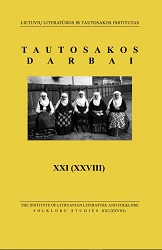Dainų fragmentiškumo refleksija lietuvių folkloristikoje
Reflections of the Fragmentary Character of Folksongs in the Lithuanian Folklore Research
Author(s): Jurgita ŪSAITYTĖSubject(s): Cultural history, Customs / Folklore, Lithuanian Literature, Baltic Languages, 19th Century
Published by: Lietuvių literatūros ir tautosakos institutas
Keywords: Folksongs; Lithuanian Folklore; fragmentary character; incoherence of expression;
Summary/Abstract: The article contains a survey of the Lithuanian folksong investigations, dealing with the fragmentary character of the song texts. The notion of fragmentary character in folksong research is applied to discuss incoherence of expression, and its saltatory nature. The problem of fragmentary character of folksongs, as well as that of their textual structure, has only gradually entered the Lithuanian scholarly discourse of folklore. Certain hints regarding peculiarities of the fragmentary structure of Lithuanian folksongs can be found in the 19th century writings already: here, attention was primarily paid to the folklore variations and improvisations, but also, the unstable nature of folksong texts, the incoherence of contents, certain singularity of their composition was pointed out. In the course of the 20th century, the studies of folksongs grew more particular, while the attitude of the folksong researchers towards the fragmentary character of the songs was increasingly revealed by their approach to the text. The special concerns of individual researchers encouraged analysis of the separate folksong fragments in terms of their meaning, origin, development, application of comparative and statistical methods, etc. Problems related to functioning, autonomy, valency, systematization of these fragments, as well as nature and causes of this phenomenon increasingly attracted scholarly attention. The textual segmentation used to be actualized in relation to the analysis of text, as an organic artistic whole, and the relationship between its meaning generating components. It was noted, that in majority of studies since the first half of the 20th century until nowadays, this strictly unspecified way of folksong analysis is mostly used as a subsidiary means in order to define and concretize the subject of the study, making it more “handy” for the comparative, synchronic, diachronic and poetical research. The segmentation of folksongs is justified by the great variety of tasks and goals posed by the researchers, while the textual components are most frequently discerned on the basis of stereotypical nature of content and form. Still, the blatant variety of concepts used to define the fragments of folksongs, and the incoherence of their usage apparently testify to the peripheral role played by the question of the folksong structure in the theory of Lithuanian folklore, contrary to the individual studies.
Journal: Tautosakos darbai
- Issue Year: 2005
- Issue No: 30
- Page Range: 100-111
- Page Count: 12
- Language: Lithuanian

